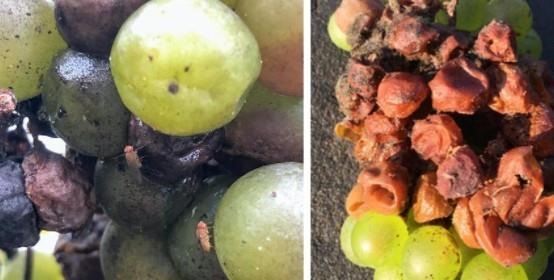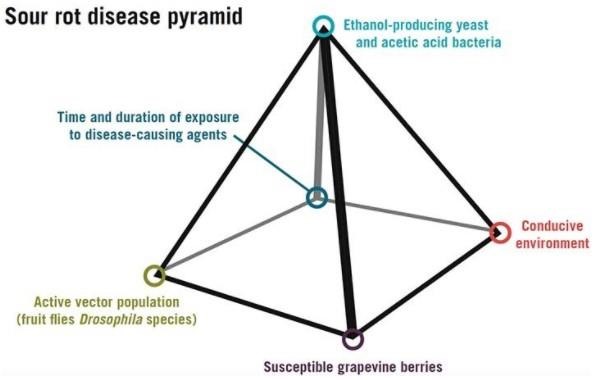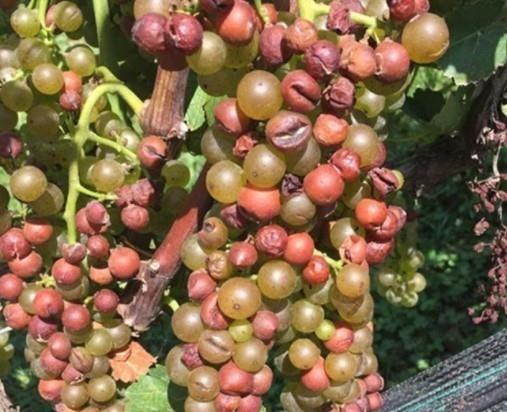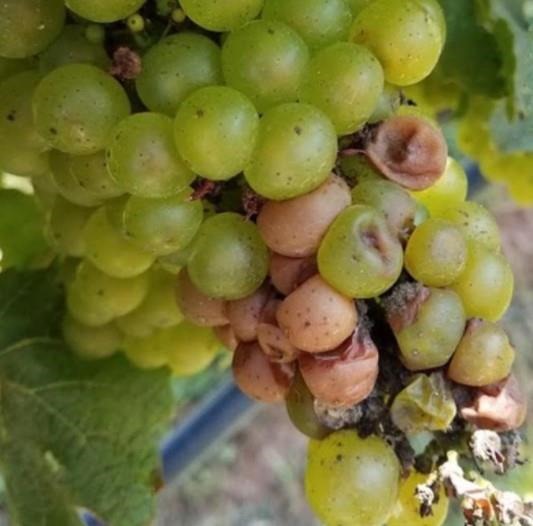The mechanism of infection and role that multiple causal organisms play in sour rot etiology are not fully understood. However, grape sour rot has been described by Hall et al. (2018a) as a disease that only exists in the presence of damaged fruit, ethanol-producing yeast (Metschnikowia, Pichia, and Saccharomyces species), acetic acid bacteria (AAB; Acetobacter and Gluconobacter species), and Drosophila species (fruit flies). Sour rot infections appear to be a function of AAB, yeast, and fruit flies on damaged grape berries that encourages disease progression throughout the entire cluster as ripening progresses. Secondary or simultaneous invasion from fungal pathogens like Botrytis cinerea can be observed in sour-rotted clusters (Figure 1).

Figure 1. Drosophila species on grape clusters (left) and Botrytis bunch rot on sour rot-infected grape clusters (right). Note the fungal growth, which is not part of the sour rot complex but exacerbates the damage. Left photo courtesy of Rachael White, University of Georgia; right photo courtesy of Cain Hickey, Penn State Extension.
Range and Causal Conditions
Grape sour rot is especially prevalent in wet, humid environments, like those observed in the eastern United States. All four of the major disease components (damaged fruit, yeast, bacteria, and fruit flies) are often present in eastern U.S. vineyards. The sour rot disease pyramid shows the disease-causing agents that are currently understood to cause grape sour rot (Figure 2). Sour rot symptoms have been observed when berries are around 15 Brix and daily temperatures are at least 68°F (Hall et al. 2018a; Figure 3). Note that the timing of symptom expression will likely depend on several factors that collectively impact cluster integrity, such as cluster architecture, canopy management practices, and management of cluster diseases early in the season. The disease infiltrates through damaged berry skins (Figure 4). Tight-clustered cultivars (e.g., ‘Pinot gris’, ‘Riesling’, ‘Sauvignon blanc’, ‘Vignoles’) are at greatest risk compared to those that have looser clusters (e.g., ‘Petit Manseng’ and ‘Petit Verdot’), although field observations of ‘Chardonnay’ suggest that clones can vary in their susceptibility to sour rot, possibly in relation to cluster morphology. Some cultivars have a propensity to crack with an influx of water due to late season rains. Regardless of cultivar, rainy and cloudy conditions exacerbate sour rot symptoms. Sour rot levels can rise if harvest is delayed late into the fall in an attempt to raise Brix when increased pH and decreased acidity are the only compositional changes to the fruit.

Figure 2. The sour rot disease pyramid shows the disease-causing agents that researchers currently believe cause grape sour rot. The pyramid’s points include susceptible grapevine berries, a Drosophila species vector, an ethanol-producing yeast, acetic acid bacteria, a conducive environment for pathogens, and time and duration of exposure to the disease-causing agents.

Figure 3. Sour rot infection in the post-veraison period. Photo courtesy of Cain Hickey, Penn State Extension.

Figure 4. ‘Vidal blanc’ with damaged skins and sour rot symptoms. Photo courtesy of Cain Hickey, Penn State Extension.
Symptoms and Identification
Barata et al. (2012) have suggested that damage to berries allows sour rot to initiate. The causal agent of the damage is not relevant to sour rot, but any damage results in exploitation of the berry pulp by fruit flies, AAB, and yeast. Fruit flies are attracted to the damaged berries and thus act as vectors that transport AAB and yeast to injury sites in unaffected fruit clusters (Barata et al. 2012). Sour rot is then initiated through uncontrolled fermentation of the berry juice into ethanol. Ethanol is oxidized by AAB into acetic acid, which then turns the fruit shades of brown and causes the pulp to liquefy and emit a sour vinegar aroma, giving the disease its name. In fact, the smell of vinegar permeates the air and is indicative of sour rot. Damaged and rotting fruit attract more fruit flies, which continue the cycle by spreading AAB and yeast to unaffected fruit. The fermented pulp can also ooze and drip onto the other berries within the cluster, spreading the infection to previously undamaged berries. Sour rot can be visually distinctive, with deflated, tan to brown berries and no obvious fungal structures (Figure 5), though the disease can often coincide with Botrytis bunch rot infections (see Figure 1). Sour rot can resemble sunscald, but the scent of acetic acid is a diagnostic key to identifying this disease complex.

Figure 5. Sour rot symptoms on ‘Chardonnay’. Sour rot can manifest as browned berries with no fungal infections (left), but the vinegar smell is diagnostic of this rot complex. Photo courtesy of Cain Hickey, Penn State Extension.
Management
Sour rot has been historically difficult to manage. The disease complex, its environmental requirements, and the factors that cause sour rot are still in question by plant pathologists. Until recently, this lack of knowledge has limited effective chemical management options. Planting cultivars that have been observed to be less susceptible to sour rot, such as vinifera cultivars like ‘Petit Verdot’ and ‘Cabernet franc’ and hybrid cultivars like ‘Chambourcin’ and ‘Chardonel’, takes advantage of genetics to mitigate sour rot development in the vineyard. Further, making judicious harvest decisions is important to limiting sour rot incidence. As grapes are left on the vine, grape berries tend to become softer, acidity declines, and pH increases. Sour rot has been observed to increase over time in the post-veraison period. Some cultivars, like “aromatic” whites (e.g., ‘Sauvignon blanc’, ‘Muscat ottonel’, ‘Riesling’), may attain acceptable varietal character at relatively low Brix levels. It is therefore important to weigh risks: do you want to risk crop loss and/or reduced wine quality due to sour rot, or do you want to harvest a full crop and use winemaking tools to modify must composition to produce a well-balanced, finished wine? Only one choice can be made for certain cultivars in some vintages.
Sour rot can be partly managed through cultural practices that improve air movement and spray penetration to the fruit zone. Management strategies should focus on creating an environment that limits one or more of the disease-causing factors, such as controlling or mitigating fruit fly infestations, preventing berry damage, choosing a trellis style that reduces canopy density, or managing the canopy to optimize spray penetration and evaporation rates. Canopy management can decrease disease pressure; Hall et al. (2018b) documented higher disease severity in research plots with denser canopies and less-managed vineyard floors. Similarly, Blaauw et al. (2019 and 2020) and Hickey et al. (2018) documented a decrease in sour rot incidence and severity with fruit zone leaf removal in ‘Chardonnay’. Good weed management and carefully mowed row middles will also increase airflow and reduce drying times in canopy and fruit.
In addition to cultural practices, a chemical program using antimicrobials and insecticides directed at controlling yeast, AAB, and fruit flies can further minimize risk of sour rot. For example, weekly applications of insecticides and antimicrobial sprays (commencing at 15 Brix) resulted in a 64 percent reduction of sour rot severity when compared to untreated vines (Hall et al. 2018b). However, ongoing work suggests that less frequent sprays of insecticides and antimicrobials after 15 Brix will help regulate sour rot.
As with the control of many vineyard diseases, an integrated approach that combines cultural and chemical programs will optimize sour rot management. However, recent work suggests that it is important to use insecticides judiciously in order to reduce the incidence of resistance buildup in fruit flies and other insects (Loeb and Walter- Peterson 2019). Resistance management should involve effective rotations of insecticides and fungicides with different modes of action.
Summary
Grape sour rot is a disease complex characterized by the smell of acetic acid and browning of grape berries. As berries ripen, the grapes begin to ooze rotting pulp. Fruit flies, which are attracted to damaged berries, are an important vector for the AAB and yeast that incite the disease. Management options are limited, but it is possible to minimize sour rot damage. Limiting sour rot begins with growing cultivars that infrequently show symptoms of this disease complex. Canopy management is important to prevent excessive shading, improve airflow, and increase chemical deposition to the fruiting zone. Limiting mechanical and insect damage to fruit is also key to reducing the effect of the disease components. The addition of an insecticide and antimicrobial chemical program directed toward limiting sour rot causal agents (AAB, yeast, and fruit flies) will provide significantly better control than using only one form of disease management. Finally, scouting and harvesting before sour rot incidence and severity peak will reduce the need to sort fruit and limit microbe introduction into winemaking facilities.
Source : psu.edu